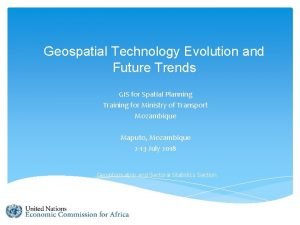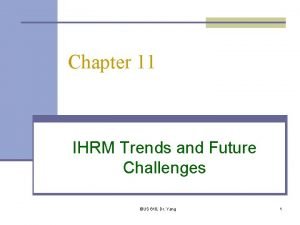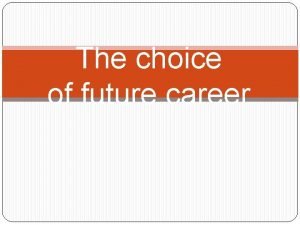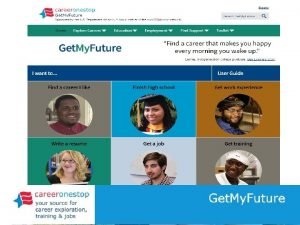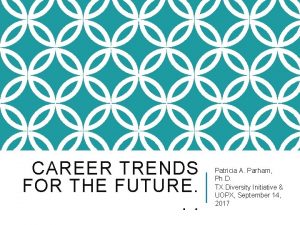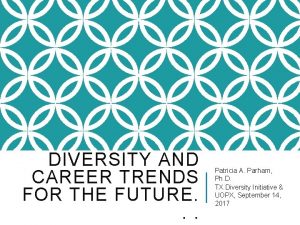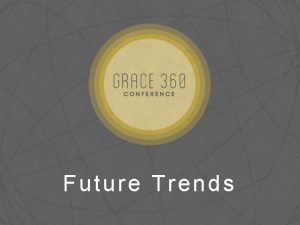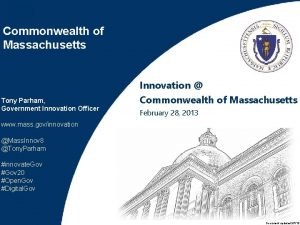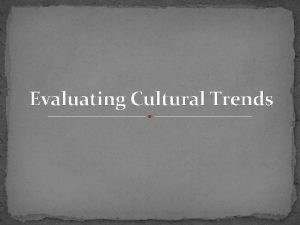CAREER TRENDS FOR THE FUTURE Patricia A Parham











































- Slides: 43

CAREER TRENDS FOR THE FUTURE. . . Patricia A. Parham, Ph. D. Dallas Campus Research Symposium, U. of Phoenix June 10, 2017

MAKE A PREDICTION, ANY PREDICTION, FOR HOW WORK WILL BE DIFFERENT IN THE FUTURE. . . Demographics Economics Globalization Technology So how do we prepare students to navigate a future that is unknown and unknowable?

DEMOGRAPHIC TRENDS Shifting US demographics Millennials Aging population Ethnic Diversity Women Global Demographics Developed world – aging and shrinking – aging + fertility rates Germany, Italy, and Japan expecting 14 -25% population decline in 10 years Developing world – young and growing

THE 2020 WORKPLACE 2005 Traditionalists Baby Boomers Generation X Millennials 4% 3% 1% 2010 2015 2020 8% 22% 23% 22% 21% 20% 25% 31% 38% 36% 45% 50%

REALITY CHECK… The number of Americans under the age of 25 with at least a bachelor's degree has grown 38 percent since 2000. Wages for young college graduates have fallen in the past decade. By 2025, Gen Y is expected to comprise up to 75% percent of the total workforce…. In 2016, Gen Y surpassed the number of Baby Boomers in the work force …. . yet currently just 7% percent work for America’s largest Fortune 500 companies.

TOP 10 MILLENNIAL EMPLOYERS 1. Armed Forces 2. Wal-Mart 3. Starbucks 4. Target 5. Best Buy 6. Mc. Donald’s 7. Abercrombie & Fitch 8. YMCA 9. CVS Caremark 10. UPS Data and analytics company Identified. com analyzed the Facebook profiles of 4 million Gen -Y users, aged 18 to 29, in November 2011. Of those reviewed, most (90 percent) lived in the U. S. and listed at least one college (80 percent). However, just a third (36 percent) listed a job entry on their profiles, possibly because they view their education as a life-long identifier and their job as more temporary.

ECONOMIC TRENDS The Knowledge Economy Rise of the “Tacit” Workforce – adaptable, selfmanagement/development, systems thinking Nonroutine problem solving, judgment, listening, data analysis, relationship building, collaborating, communicating Productivity in Manufacturing More sophisticated production Welding not enough Outsourcing Cheaper labor, connectivity

1 2 3 4 5 6 7 8 9 10 11 12 13 14 15 16 17 18 19 20 Largest Wal-Mart IBM Mc. Donald’s United Parcel Service Target Kroger Sears Holdings General Electric Citigroup Albertson’s Fed. Ex General Motors United Technologies CVS Altria Group Verizon Communications Aramark Berkshire Hathaway AT&T Home Depot 1 2 3 4 5 6 7 8 9 10 11 12 13 14 15 16 17 18 19 20 Most Admired Apple Google Amazon. com Coca-Cola IBM Fed. Ex Berkshire Hathaway Starbucks Procter & Gamble Southwest Airlines Mc. Donald's Johnson & Johnson Walt Disney BMW General Electric American Express Microsoft 3 M Caterpillar Costco Wholesale

1 2 3 4 5 6 7 8 9 10 11 12 13 14 15 16 17 18 19 20 Largest Wal-Mart IBM Mc. Donald’s United Parcel Service Target Kroger Sears Holdings General Electric Citigroup Albertson’s Fed. Ex General Motors United Technologies CVS Altria Group Verizon Communications Aramark Berkshire Hathaway AT&T Home Depot 1 2 3 4 5 6 7 8 9 10 11 12 13 14 15 16 17 18 19 20 Most Admired Apple Google Amazon. com Coca-Cola IBM Fed. Ex Berkshire Hathaway Starbucks Procter & Gamble Southwest Airlines Mc. Donald's Johnson & Johnson Walt Disney BMW General Electric American Express Microsoft 3 M Caterpillar Costco Wholesale

REALITY CHECK… Number of Employees? Facebook Wal-Mart Apple Yum! Brands Google Mc. Donalds Cloudera UPS

Number of Employees? Facebook Wal-Mart 2. 2 million 1. 4 in US Yum! Brands 523, 000 Mc. Donalds 440, 000 UPS 399, 000 6, 000 Apple 50, 000 Google 42, 000 Cloudera 400

GLOBALIZATION “The simple definition of globalization is the interweaving of markets, technology, information systems, and telecommunications networks in a way that is shrinking the world from a size medium to a size small. ” Tom Freidman, The World is Flat Merging of cultures Integrated supply chains Global reach for large and small companies Communication technologies Cost of international travel

LIVING AND TRAVELING “The total number of people living outside their country of birth is larger than any other time in history. International migrants would constitute the world’s fifth most populous country if they all lived in the same place. ” United National Population Fund 2006 Microsoft has unveiled a system that can translate what you say into Mandarin and play it back - in your voice.

REALITY CHECK… Total number of U. S. jobs outsourced in 2011 Percent of CFO’s surveyed who said their firm was currently outsourcing Percent of CFO’s who favored India for outsourcing Percent of CFO’s who favored China for outsourcing Outsourcing By Sector Manufacturing IT Services R&D Distribution Call or Help Centers 2, 273, 392 35 % 24 % 18 % Percent of Companies 53 % 43 % 38 % 26 % 12 % Source: Sourcing Line Computer Economics

TECHNOLOGY Since 2000 Short History of the Internet 1969 Advanced Research Projects Agency goes online connecting four U. S. universities 1972 Email 1973 TCP/IP and FTP 1982 1984 The word "internet" is used for the first time Domain Name System (DNS) is established 1994 Netscape 1994 Yahoo! 1995 Compu. Serve, America Online, and Prodigy start providing dial-up internet access 1995 Amazon 1998 Google 1999 My. Space 1999 Napster 2000 i. Tunes 2001 Wikipedia 2003 Linked. In 2003 Skype 2004 Facebook Firefox 2005 You. Tube 2006 2010 Twitter Instagram 2011 Snap. Chat

PROGRAMMING JOBS 2006 -2012

DOES DISRUP TIVE TECHN OLOGY LOOK LIKE? OR VENDIN G MACHI NES FOR

PRACTICALLY HUMAN: CAN SMART MACHINES DO YOUR JOB? The advance of technology creating jobs - but it's also taking a toll on people because they so easily can be replaced. In the U. S. , more than 1. 1 million secretaries vanished from the job market between 2000 and 2010. Over the same period, the number of telephone operators plunged by 64 percent, word processors and typists by 63 percent, travel agents by 46 percent and bookkeepers by 26 percent, according to Labor Department statistics.

PRACTICALLY HUMAN: CAN SMART MACHINES DO YOUR JOB? Comerica, a bank based in Dallas, is using new video-conferencing equipment that lets cash-management experts make pitches to potential corporate clients from their desks. Those experts, based in Livonia, Mich. , used to board planes and visit prospects in person. The British-Australian mining giant Rio Tinto announced plans last year to invest $518 million in the world's first long-haul, heavy-duty driverless train system at its Pilbara iron ore mines in Western Australia. The automated trains are expected to start running next year. The trains are part of what Rio Tinto calls its "Mine of the Future" program, which includes 150 driverless trucks and automated drills.




PRACTICALLY HUMAN: CAN SMART MACHINES DO YOUR JOB? Google's driverless car and the Pentagon's drone aircraft are raising the specter of highways and skies filled with cars and planes that can get around by themselves. The trains on several Japanese rail lines run by themselves and employs only about 60 employees at its 16 stations. "Certainly, using the automated systems does reduce the number of staff we need, " says Katsuya Hagane. "A pilotless airliner is going to come; it's just a question of when, " James Albaugh, retired CEO of Boeing Commercial Airlines, said in 2011, according to IEEE Spectrum magazine. "You'll see it in freighters first, over water probably, landing very close to the shore. " Driverless cars will have a revolutionary impact on traffic one day - and the job market. In the United States alone, 3. 1 million people drive trucks for a living, 573, 000 drive buses, 342, 000 drive taxis or limousines. All those jobs will be threatened by automated vehicles.


CONNECTIVITY Cisco’s Social Media Survey of Millennials 2/3’s will ask about social media during job interview 56% will not take a job from a company that bans social media or they will work around the ban 1/3 prioritize social media access and mobility device freedom over salary 68% believe that corporate devices should be used for social media and personal use 50% would rather lose their wallet or purse than their phone. 70% believe being in an office is unnecessary http: //www. cisco. com/en/US/netsol/ns 1120. html

SMARTPHONES BY AGE AND INCOME 90 80 77 75 74 80 6970 65 6465 70 63 60 58 56 60 53 51 5052 48 44 50 43 42 41 38 40 3230 31 27 24 30 23 21 18 1617 161516 20 10 0 18 -24 25 -34 35 -44 45 -54 55 -64 65+ <$15 k-35 k $35 k-50 $50 k-75 k $75 k-100 k $100+ Neilso n

“BIG DATA” Data scientist: The sexiest job of the 21 st century. Davenport & Patil, HBR, 2012 Where did the “Data Scientist” come from? What do they do? What kind of people will companies need to do these jobs?

“BIG DATA” Data scientist: The sexiest job of the 21 st century. Davenport & Patil, HBR, 2012 Where did the “Data Scientist” come from? “The traditional backgrounds of people you saw 10 -15 ago just don’t cut it these days. ” What do they do? Program / analyze / communicate Turn data into information Understand communicate What kind of people will companies need to do these jobs? “Hacker, analyst, communicator, trusted advisor” years

If you are looking for a career where your services will be in high demand, you should find something where you provide a scarce, complementary service to something that is getting ubiquitous and cheap. So what's getting ubiquitous and cheap? Data. And what is complementary to data? Analysis. Prof. Hal Varian, UC Berkeley, Chief Economist at Google

“BIG DATA” At the heart of the biggest technological changes today is what computer scientists call "Big Data. " Computers thrive on information, and they're feasting on an unprecedented amount of it - from the Internet, from Twitter messages and other social media sources, from the barcodes and sensors being slapped on everything. Wal-Mart's analysis of Twitter traffic helped convince it to increase the amount of "Avengers" merchandise it offered when the superhero movie came out in 2012 and to introduce a private-label corn chip in the American Southwest.

HOW HAS HIGHER EDUCATION CHANGED IN 10 YEARS? Demographics Greater demand Increasing diversity of students Economics Costs Defunding of public education Globalization International market for education Rise of China and developing world Technology Blackboard Ultra

COST OF COLLEGE TUITION Public Institutions 2010– 11 2000– 01 1990– 91 1980– 81 All Institutions 13, 564 7, 586 4, 757 2, 373 Private Institutions 2010– 11 2000– 01 1990– 91 1980– 81 All Institutions 32, 026 21, 373 12, 910 5, 470 4 -Year Institutions 15, 918 8, 653 5, 243 2, 550 4 -Year Institutions 32, 617 21, 856 13, 237 5, 594 2 -Year Institutions 8, 085 4, 839 3, 467 2, 027 2 -Year Institutions 23, 871 14, 907 9, 302 4, 303 Projected Cost of College in 18 Years (2029) 4 Year Tuition and Fees Figures do not include room and board, books, etc. Private College $355, 900 Public University $102, 900 2 Year Community College $35, 700 U. S. Department of Education, National Center for Education Statistics

RISE OF ONLINE EDUCATION Total number of students who took a class online in 2010 6. 1 million Percent increase in online students from 2009 – 2010 10. 1 % Total number of accredited online universities 277 Average annual tuition cost of an online university $ 14, 850 Percent of online universities that have a student population larger than 20, 000 19 % Percent of US colleges that offer online bachelors degrees 34 % Number of students enrolled in the University of Phoenix online campus 532, 600 Sanjay Sarma appointed as MIT’s first director of digital learning Mechanical engineering professor will shepherd efforts to integrate elements of online education into traditional MIT courses.

NEXT 10 YEARS Demographics Diversity of programs for different goals and preparation Economics The $10, 000 degree Split between tenure and non-tenure teaching grows Globalization MOOCS US no longer first choice for international students Technology mediated classroom Video / Twitter / Virtual

WHAT WILL WORK LOOK LIKE IN THE FUTURE?

NEW ORGANIZATIONAL STRUCTURE – 3 D MATRIX As reported in the Wall Street Journal (August 6, 2009), Cisco’s CEO, John Chambers, wants to see the company move into more than two dozen new businesses, from consumer camcorders to giant TV screens for stadiums. In order to manage these initiatives, Chambers has replaced Cisco’s top-down decision making with committees of executives from across the company. Some teams provide strategic advice and evaluate the progress of these projects. In total, Cisco now has 59 internal standing committees.

VALVE CO-FOUNDER GABE NEWELL Valve Software—the company behind the Half-Life, Counter. Strike, and Portal video game - has a unique corporate structure rarely seen at such a large company: Valve has 300 employees but no managers or bosses at all. Why? “When we started Valve [in 1996], we thought about what the company needed to be good at. We realized that here, our job was to create things that hadn’t existed before. Managers are good at institutionalizing procedures, but in our line of work that’s not always good. Sometimes the skills in one generation of product are irrelevant to the skills in another generation. Our industry is in such technological, design, and artistic flux that we need somebody who can recognize that. It’s pretty rare for someone to be in a lead role on two consecutive projects. ”

TRUST AND RELATIONSHIPS AS CURRENCY MANAGER?

HOW WILL THESE TRENDS AFFECT YOU? Are you ignoring trends that could shake up your business? Ofek & Wathieu, HBR 2010 Understand the trends Impact / scope / endurance Explore the trends How are they changing the goals, beliefs, perceptions of consumers? How do consumers view your product / service? Do changing goals, beliefs and perceptions of customers fit your profession? What can you do to meet those changing needs.

SKILLS FOR THE CENTURY ST 21 Technical skills Communication technology Data analytics Interpersonal skills Leading without traditional bases of hierarchical power Visioning – Narrative Conflict resolution Team building / Networking Adaptation / Learning Finding information Curiosity

WORK IN THE NEXT CENTURY MIGHT BE. . . Project-based virtual workforces that never co-locate How do you create company culture and gain synergies from work? Leaderless organizations How are goals set and decisions made? How do leaders develop? B 2 B businesses so that each does only their core competency What does company culture look like for the core production/service organization? Companies where employees speak a dozen different languages? How do you communicate efficiently? How do you avoid typecasting? Data driven companies accumulating more an more data? How do you ‘sell’ data to the right companies at the right times?

THANK YOU!

REFERENCES Ofek, Elie, and Wathieu. 2010. Are You Ignoring Trends That Could Shake Up Your Business? Harvard Business Review, July – August 2010. Meister and Willyerd. 2010. Ten Trends Shaping the Future Workplace Now in The 2020 Workplace, New York, NY: Harper. Collins. Davenport and Patil. 2012. Data Scientist: The Sexiest Job of the 21 st Century, Harvard Business Review, October 2012, p. 72 -76.
 Future perfect continuous exercises
Future perfect continuous exercises Future perfect simple vs future perfect continuous
Future perfect simple vs future perfect continuous Charles parham azusa street revival
Charles parham azusa street revival Parham
Parham Charles parham azusa street revival
Charles parham azusa street revival Macbeth character map
Macbeth character map Parham
Parham Google mapia
Google mapia Ihrm trends and future challenges
Ihrm trends and future challenges The current and future trends of media and information
The current and future trends of media and information Future trends
Future trends Ihrm trends
Ihrm trends Formulas for career success
Formulas for career success Fcs lanchpad
Fcs lanchpad Future career choice
Future career choice Career one stop
Career one stop Get my future
Get my future Future perfect
Future perfect Future progressive in the past
Future progressive in the past Future continuous and future perfect
Future continuous and future perfect Simple present simple past simple future
Simple present simple past simple future Future continuous travel
Future continuous travel 1 2 3 kondicional u engleskom jeziku
1 2 3 kondicional u engleskom jeziku Future perfect future continuous exercises
Future perfect future continuous exercises Verbal times
Verbal times Future nurse programme
Future nurse programme Future plans and finished future actions
Future plans and finished future actions Big brother rösta
Big brother rösta Verktyg för automatisering av utbetalningar
Verktyg för automatisering av utbetalningar Kolposkopi px
Kolposkopi px Bat mitza
Bat mitza Ro i rom pax
Ro i rom pax Stig kerman
Stig kerman Varför kallas perioden 1918-1939 för mellankrigstiden
Varför kallas perioden 1918-1939 för mellankrigstiden Ledningssystem för verksamhetsinformation
Ledningssystem för verksamhetsinformation Novell typiska drag
Novell typiska drag Tack för att ni har lyssnat
Tack för att ni har lyssnat Borstål, egenskaper
Borstål, egenskaper Cks
Cks Texter för hinduer tantra
Texter för hinduer tantra Bo bergman jag fryser om dina händer
Bo bergman jag fryser om dina händer Inköpsprocessen steg för steg
Inköpsprocessen steg för steg Påbyggnader för flakfordon
Påbyggnader för flakfordon Egg för emanuel
Egg för emanuel







